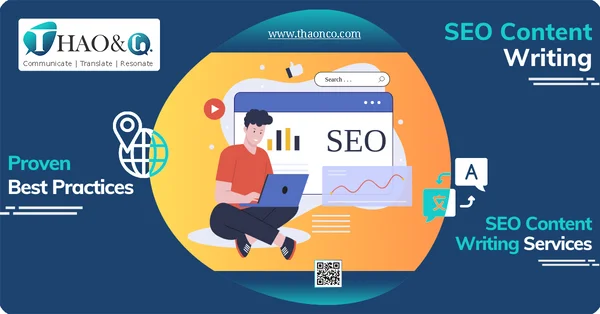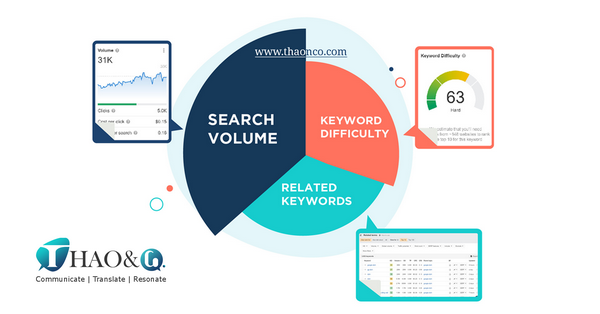Think of search engine results pages as a giant game board. You want your website to have a spot at the very top. But with over 1 billion websites vying for attention, how will you beat the odds? This is where mastering SEO content writing practices comes in – and it’s not just about stuffing as many keywords in as possible, so search engines notice you.
True winning strategies keep the user experience at their core by crafting valuable, engaging content for what readers actually search for.
Ready to learn the rules of the SEO game and tips for coming out on top? Let’s dive into some key best practices that the SEO experts at Thao & Co. swear by to create transformational content that both search engines and visitors fall in love with.
Before you can craft compelling content, you must understand your audience. Who are they? What do they care about? How can you best provide value to them? Audiences ultimately determine the success of your content marketing and SEO. Use these key techniques to delve into audience insights.
Start by asking exploring basic questions to classify your audience demographics:

Demographic analysis is a great starting point, but it just skims the surface. To truly connect with your audience, you need to dive deeper into psychographic profiling.
Now that you have a good understanding of your audience, it’s time to show this audience awareness within your content:
As you continuously analyze your audience, you can gain insights to craft tailored content that always hits the mark. Please your readers, and SEO success will follow.
As we have established earlier, identifying the terms and phrases that your target audience actually use and search for (known as keywords in the SEO sphere) is extremely important for content visibility and traffic. But how to lock down on those keywords when there are literally millions of options?
You can get valuable data and trends from keyword research tools such as SEMrush, Ahrefs and Google’s Keyword Planner. Simply type in some keywords related to your niche and you will receive keyword suggestions, monthly search volume, and keyword difficulty scores.
Search volume tells you how often a keyword is entered into a search engine in a month. High numbers means stronger demand – an opportunity for clicks and traffic!
But extremely high volume on hyper competitive phrases also means more content rivalry. It’s best to seek keywords with adequate search volume for your niche.
Keyword difficulty is a metric predicting how hard it may be to rank for a particular keyword based on current competition levels. Typically, keywords with lower difficulty offer the best ROI potential for newer sites. Start with these little gems. You can work up to more competitive keywords once you accumulate backlinks and engagement over time.
Want an expanded deep dive into proven keyword research methods? Check out Thao & Co.’s detailed guide to developing your optimal SEO keyword strategy. By rigorously researching terms that your audience cares about, your content will feel rewarding for visitors and search engines alike.
The Internet is like an ocean teeming with billions of web pages, all clamoring for the attention of searchers as they scan results. Your page needs some seriously good bait to reel readers in.

Headlines serve the critical function of distilling your content into a compelling one-liner while incorporating SEO keywords. But don’t get so fixated on keywords that headlines become confusing or too loaded. Creative, benefit-focused headlines attract the most clicks and engagement.
What real pain points motivate your audience? What aspirations do they have? Build these emotional triggers into your headlines. For example, if you sell hiking shoes, your review article could read “Tired of Blistered Feet Ruining Your Adventures?” Pique curiosity, empathy, and interest right from the start.
People trust their friends for opinions and making decisions. That’s why it’s important to write brisk and relatable headlines as if you are speaking to a friend. For example, “Making Sense of Markdown Formatting for Beginners” adopts an informal, friendly tone that is more likely to connect well with readers than “Introduction to Markdown Formatting.”
Numbered list-style headlines are proven to grab attention, especially for informational pieces. Everyone wants to know what “5 Must-Have Fashion Items for An Amazing New Year Eve” are. Make sure to arrange keywords flexibly within your list items.
Simply packing your pages with keywords won’t get you anywhere. At its core, SEO aims to satisfy searcher intent with content that directly answers their questions and needs. At Thao & Co., we create truly valuable content worth sharing and linking to by:
Before you start writing any new piece of content, first analyze:
For example, a detailed guide troubleshooting the “Error 404 Not Found” messages will provide immense value for anyone who encounters this roadblock. Questions you can answer and problems you can solve form the building blocks for stellar content.
Just like with headlines, write your content the way you speak to a friend. Turn complex advice into bite-sized points and everyday analogies. Go for short sentences, paragraph chunks, descriptive yet concise language. This helps boost comprehension and readability, even amongst highly technical topics.
Don’t forget to supplement your writing with data, stats, visuals, and videos where possible. Readers love good examples to put complex explanations into action. It’s important to cater to visual and kinesthetic learners accustomed to interacting with dynamic multimedia resources daily.
While it’s important to avoid keyword stuffing, you shouldn’t overlook the role of strategic keyword placement either. Here are some tips to help you weave your keywords like magic threads to boost discoverability and ranking potential.
Before handing over your article to the publishing team, take a deep breath and prepare for the final step: self-editing. This ensures your content shines with clarity, consistency, and conciseness, and credibility.
We have been talking about internal linking, or interlinking, quite a lot. So, what exactly is internal linking?
Internal linking refers to linking one webpage to another within the same website domain using anchor text and hyperlinks. This creates interconnected clusters around high-value themes that clearly communicate your expertise to search engines.
For example, if you are a yoga studio, your website probably has all kinds of yoga content such as follow-along videos, guided meditations, teacher tips, etc. Here’s how you can connect these seamlessly with internal linking:
Mapping a content plan with internal linking in mind makes it easier to naturally connect related topics and boost visibility for your most important pages.
During the development phase of your website content plan, identify clusters of related content that can be interlinked. This intentional approach allows you to craft complementary pages that seamlessly link to one another by topic.
For a step-by-step guide on building a structured content plan optimized for both organic traffic and conversions, see our guide to strategic website content planning. Factoring internal linking potential into your plan will pay off in search visibility for your important pages.
So you’ve poured your heart and soul into crafting an excellent article, but will people actually click it amidst the crowded SERP listings? That crucial first impression depends on finely tuned meta descriptions and SEO titles.
A meta description is the short snippet teasing what your page offers. It convinces searchers that your content can answer their question.
For example, a yoga page could use: “Looking for beginner yoga tutorials? Our step-by-step videos cover poses, proper breathing, and guided meditations you can do at home without equipment.” Short, sweet, and straight to the point.
SEO title tags, on the other hand, tell both search engines and visitors the topic focus. Together, these on-page elements set expectations while enticing clicks. Here’s your cheat sheet to optimize your meta descriptions and title tags for SEO:
Exceptional content doesn’t just happen. It requires rigorous audience and keyword research, linguistic and cultural expertise, as well as creativity and SEO know-hows to create content that balances both search engine and human appeal.
Yet most businesses barely have enough hours in the week to handle core operations, let alone content creation. This is where Thao & Co. comes in.
Our content specialists handle the entire SEO content process: from research to writing and publishing to free up your schedule so you can focus on important business goals. We accelerate your success with strategic content that:
Drop your details on our Get a Quote page and we’ll get back to you swiftly for a personalized content assessment tailored to your business. Imagine – a steady stream of high-quality SEO content expertly managed by Thao & Co. You focus on your business vision, we’ll handle the content creation magic.